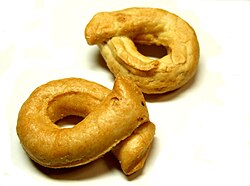 Tarallini | |
| Type | Cracker |
|---|---|
| Place of origin | Italy |
| Region or state | Southern Italy |
| Main ingredients | Wheat flour, yeast, water, olive oil, fennel seeds, black pepper |
| Variations | Tarallini |

Taralli (sg.: tarallo) are toroidal Italian snack foods, common in southern Italy.[1] Wheat-based crackers similar in texture to breadsticks,[2] taralli can be sweet or savory.[3]
Taralli are classically formed into rings or ovals about 10 to 12.5 cm (3.9 to 4.9 in) in circumference. Smaller taralli, called tarallini, with a circumference of 3.8 to 7.8 cm (1.5 to 3.1 in), are sold commercially.[citation needed] Their dough may be shortened with olive oil or lard. More common historically were taralli made with lard, which produces a flakier product.[4] According to Canadian author Malcolm Gladwell in his book Outliers, "Sweets such as biscotti and taralli used to be reserved for Christmas and Easter; in Roseto they were eaten year-round."[5]
Before World War II, the coastal Mergellina region of Naples had a strong culture of taralli consumption. Among the city's poor, sitting at a table by the beach was a way to have relief from their cramped living conditions, and there, they ate taralli with almonds throughout that food writer Arthur Schwartz describes as "supposedly" made by the wives of fishermen. These were always paired with one of three drinks: beer, wine, or the sulfuric water drawn from a fountain in nearby Borgo Santa Lucia.[4]
After World War II, the area underwent urban renewal. By the 1990s, taralli were sold by vendors from carts, alongside chips and other snacks, and Neapolitans complained that the culture had ended. Elsewhere, taralli were sold at specialty bakeries, in flavors such as fennel and sun-dried tomato. They were particularly popular in the comune of Caserta.[4]
See also
[edit]References
[edit]- ^ Barbieri, S (2018). "Sensory and instrumental study of Taralli, a typical Italian bakery product". European Food Research & Technology. 244 (1): 73–82. doi:10.1007/s00217-017-2937-8. S2CID 103476996.
- ^ Moskin, Julia (10 June 2016). "Italy's answer to potato chips? Taralli, of course". New York Times. Retrieved 12 June 2022.
- ^ McGrath, Gwen; Doherty, Ken (7 February 2021). "Tasty staples from Naples". Sunday Times.
- ^ a b c Schwartz, Arthur (1998). Naples at Table: Cooking in Campania. New York: HarperCollins. pp. 88-89. ISBN 0-06-018261-X.
- ^ Gladwell, Malcolm (2008). Outliers: The Story of Success (First ed.). New York: Little, Brown and Company. p. 8. ISBN 9780316017923. OCLC 225870354.
External links
[edit]
